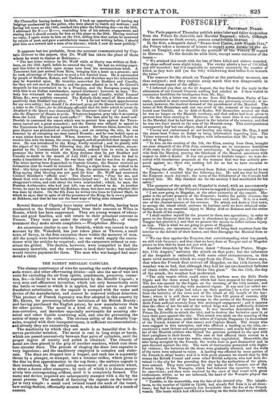THE PATENT METALLIC CAPSULES.
The clumsy contrivance of wire for securing the corks of champagne, soda-water, and other effervescing drinks—and also the use of wax and resin for excluding the air from spirits, condiments, preserves, cosme- tics, 8m—is likely to be wholly superseded by the Metallic Capsule; a very neat and efficacious invention, which not only hermetically seals the bottle or vessel to which it is applied, but also serves to prevent fraudulent substitution, as the capsule is stamped with the name and device of the manufacturer, and cannot be removed without detection. This product of French ingenuity was first adopted in this country by Mr. BETTS, for preventing inferior imitations of his British Brandy ; and having purchased the English patent, he now manufactures them for other parties. The metal is a kind of tin, which is said to be non-corrosive, and therefore especially serviceable for securing che- mical and other liquids containing acid, and also for preventing the action of damp on the cork. The obvious utility of the Metallic Cap- sules, coupled with their inexpensiveness, is sufficient recommendation ; and already they are extensively used.
The machinery by which they are made is so beautiful that it de- serves particular mention. The metal is cast in long strips or bands, which are passed successively between four pairs of cylinders, until the proper degree of tenuity and polish is obtained. The ribands of metal are then placed in the grip of another machine, which cute them into circular discs. The process of shaping the discs into capsules is very ingenious; and the machinery employed is complex and elabo- rate. The discs are dropped into a hopper, and each one is separately thrust by a plunger, or stamper, into a circular orifice, which gives to the disc its first approximation to the cap form ; the embryo capsule is then transferred, by the self-acting movement of an eccentric wheel, to about a dozen other stampers ; by each of which it is thrust succes- sively into corresponding orifices, until it is completely formed. The name and device required are subsequently stamped with a die by the usual process. The method of fastening the capsule on the bottle or jar is very simple: a small cord twisted round the neck of the vessel, bow-string-fashion, effectually secures it, with the addition of a touch of cement.


























 Previous page
Previous page